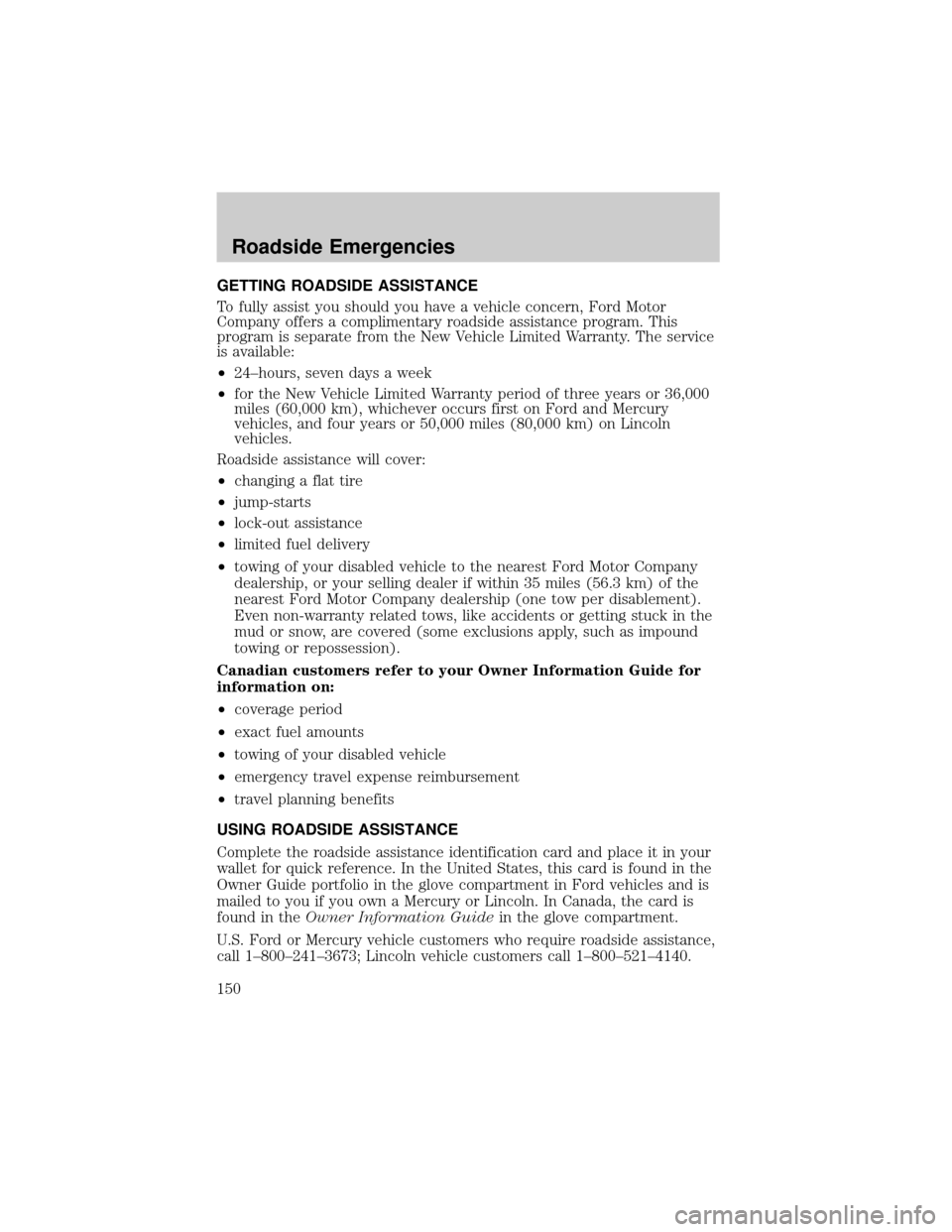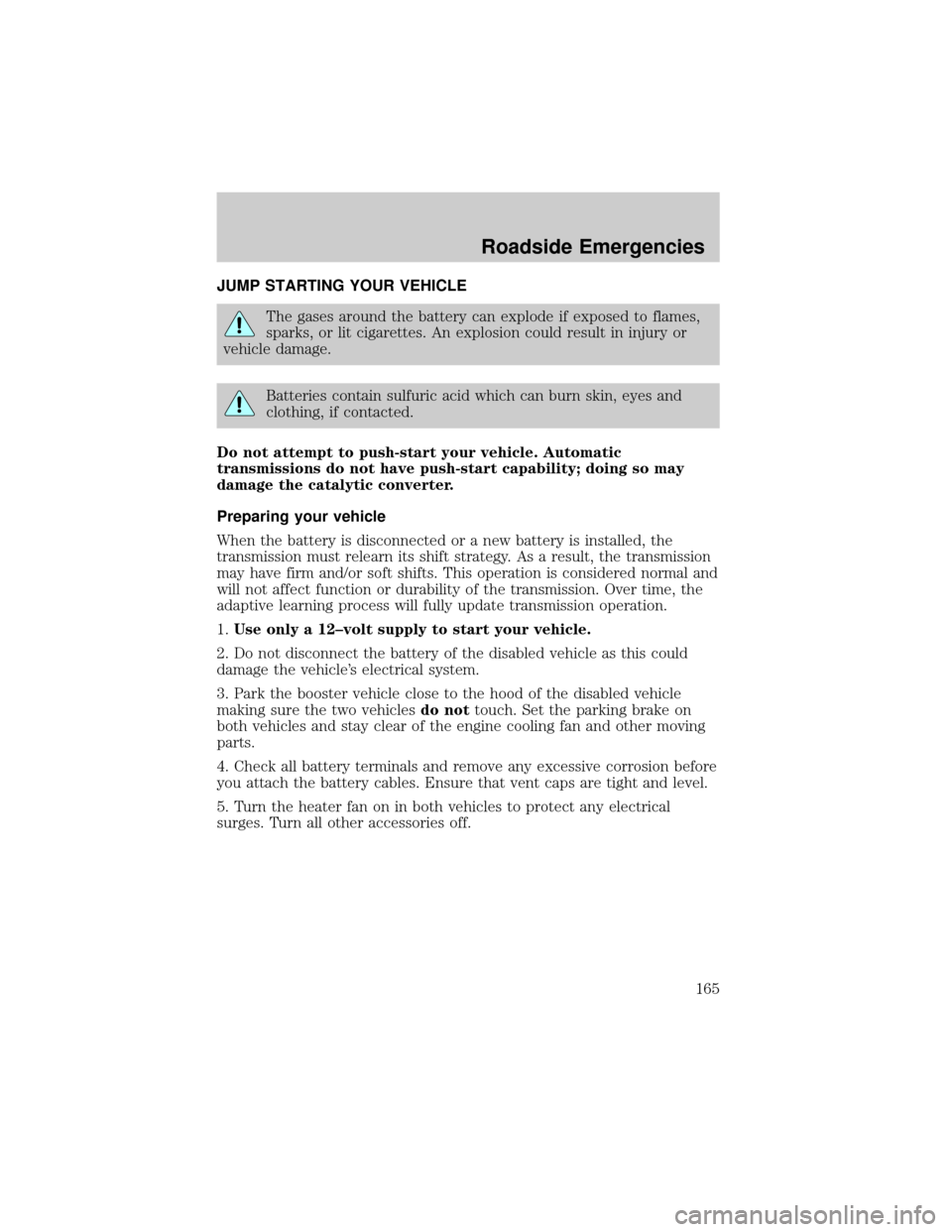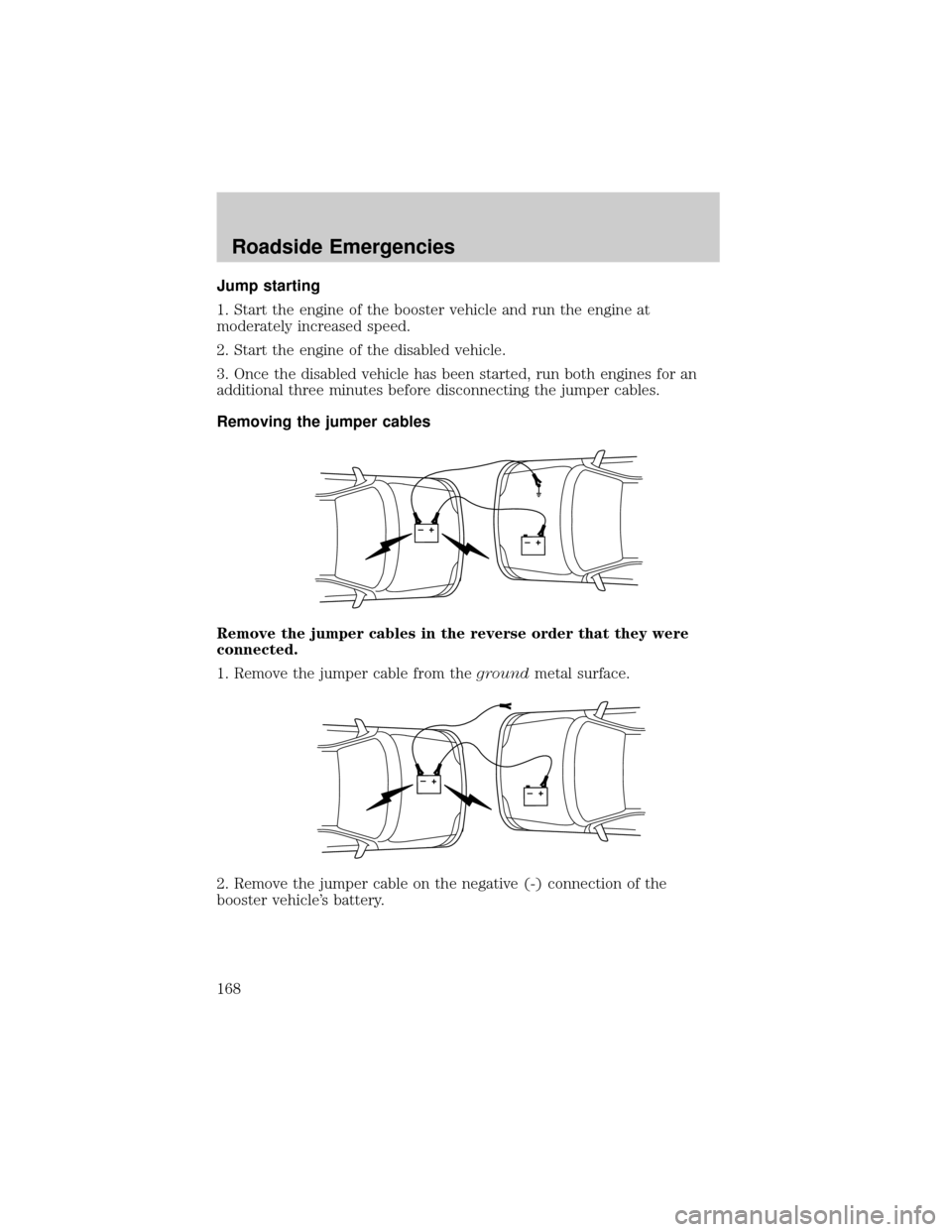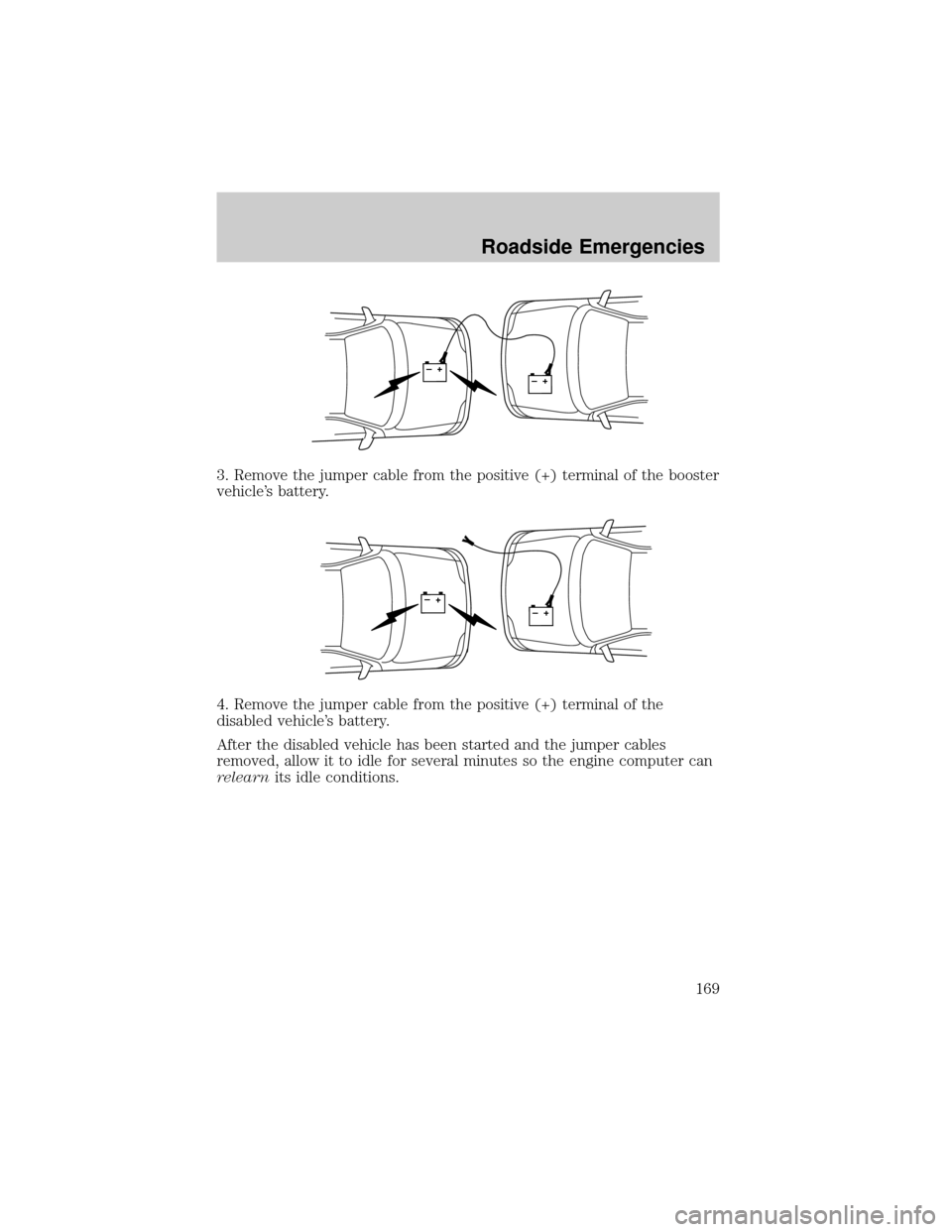2005 FORD TAURUS jump start
[x] Cancel search: jump startPage 2 of 248

Seating and Safety Restraints 88
Seating 88
Safety restraints 92
Air bags 108
Child restraints 117
Driving 130
Starting 130
Brakes 134
Traction control 136
Transmission operation 138
Vehicle loading 142
Trailer towing 146
Recreational towing 148
Roadside Emergencies 150
Getting roadside assistance 150
Hazard flasher switch 151
Fuel pump shut-off switch 151
Fuses and relays 153
Changing tires 159
Jump starting 165
Wrecker towing 170
Customer Assistance 172
Reporting safety defects (U.S. only) 180
Cleaning 181
Table of Contents
2
Page 150 of 248

GETTING ROADSIDE ASSISTANCE
To fully assist you should you have a vehicle concern, Ford Motor
Company offers a complimentary roadside assistance program. This
program is separate from the New Vehicle Limited Warranty. The service
is available:
²24±hours, seven days a week
²for the New Vehicle Limited Warranty period of three years or 36,000
miles (60,000 km), whichever occurs first on Ford and Mercury
vehicles, and four years or 50,000 miles (80,000 km) on Lincoln
vehicles.
Roadside assistance will cover:
²changing a flat tire
²jump-starts
²lock-out assistance
²limited fuel delivery
²towing of your disabled vehicle to the nearest Ford Motor Company
dealership, or your selling dealer if within 35 miles (56.3 km) of the
nearest Ford Motor Company dealership (one tow per disablement).
Even non-warranty related tows, like accidents or getting stuck in the
mud or snow, are covered (some exclusions apply, such as impound
towing or repossession).
Canadian customers refer to your Owner Information Guide for
information on:
²coverage period
²exact fuel amounts
²towing of your disabled vehicle
²emergency travel expense reimbursement
²travel planning benefits
USING ROADSIDE ASSISTANCE
Complete the roadside assistance identification card and place it in your
wallet for quick reference. In the United States, this card is found in the
Owner Guide portfolio in the glove compartment in Ford vehicles and is
mailed to you if you own a Mercury or Lincoln. In Canada, the card is
found in theOwner Information Guidein the glove compartment.
U.S. Ford or Mercury vehicle customers who require roadside assistance,
call 1±800±241±3673; Lincoln vehicle customers call 1±800±521±4140.
Roadside Emergencies
Roadside Emergencies
150
Page 165 of 248

JUMP STARTING YOUR VEHICLE
The gases around the battery can explode if exposed to flames,
sparks, or lit cigarettes. An explosion could result in injury or
vehicle damage.
Batteries contain sulfuric acid which can burn skin, eyes and
clothing, if contacted.
Do not attempt to push-start your vehicle. Automatic
transmissions do not have push-start capability; doing so may
damage the catalytic converter.
Preparing your vehicle
When the battery is disconnected or a new battery is installed, the
transmission must relearn its shift strategy. As a result, the transmission
may have firm and/or soft shifts. This operation is considered normal and
will not affect function or durability of the transmission. Over time, the
adaptive learning process will fully update transmission operation.
1.Use only a 12±volt supply to start your vehicle.
2. Do not disconnect the battery of the disabled vehicle as this could
damage the vehicle's electrical system.
3. Park the booster vehicle close to the hood of the disabled vehicle
making sure the two vehiclesdo nottouch. Set the parking brake on
both vehicles and stay clear of the engine cooling fan and other moving
parts.
4. Check all battery terminals and remove any excessive corrosion before
you attach the battery cables. Ensure that vent caps are tight and level.
5. Turn the heater fan on in both vehicles to protect any electrical
surges. Turn all other accessories off.
Roadside Emergencies
165
Page 168 of 248

Jump starting
1. Start the engine of the booster vehicle and run the engine at
moderately increased speed.
2. Start the engine of the disabled vehicle.
3. Once the disabled vehicle has been started, run both engines for an
additional three minutes before disconnecting the jumper cables.
Removing the jumper cables
Remove the jumper cables in the reverse order that they were
connected.
1. Remove the jumper cable from thegroundmetal surface.
2. Remove the jumper cable on the negative (-) connection of the
booster vehicle's battery.
+–+–
+–+–
Roadside Emergencies
168
Page 169 of 248

3. Remove the jumper cable from the positive (+) terminal of the booster
vehicle's battery.
4. Remove the jumper cable from the positive (+) terminal of the
disabled vehicle's battery.
After the disabled vehicle has been started and the jumper cables
removed, allow it to idle for several minutes so the engine computer can
relearnits idle conditions.
+–+–
+–+–
Roadside Emergencies
169
Page 244 of 248

instrument panel ....................184
interior .....................................184
interior trim ............................185
plastic parts ............................183
washing ....................................181
waxing .....................................181
wheels ......................................182
wiper blades ............................184
Climate control (see Air
conditioning or Heating) ............26
Clock adjust
AM/FM Stereo ...........................15
AM/FM/CD .................................19
AM/FM/Tape ..............................16
Compass, electronic ....................61
calibration .................................61
set zone adjustment .................61
Console ........................................67
Controls
power seat .................................90
Coolant
checking and adding ..............198
refill capacities ................202, 232
specifications ..................234±235
Cruise control
(see Speed control) ....................51
Customer Assistance ................150
Ford accessories for your
vehicle .....................................186
Ford Extended Service Plan .174
Getting assistance outside
the U.S. and Canada ..............178
Getting roadside assistance ...150
Getting the service
you need .................................172
Ordering additional owner's
literature .................................179
The Dispute Settlement
Board .......................................174Utilizing the Mediation/
Arbitration Program ...............177
D
Daytime running lamps
(see Lamps) ................................30
Defrost
rear window ..............................28
Dipstick
automatic transmission
fluid ..........................................216
engine oil .................................192
Doors
lubricant specifications ..........234
Driving under special
conditions ..................................141
through water .........................142
E
Electronic message center .........58
Emergencies, roadside
jump-starting ..........................165
Emergency Flashers .................151
Emission control system ..........212
Engine ................................235±236
cleaning ...................................182
coolant .....................................198
idle speed control ...................196
lubrication specifications 234±235
refill capacities ........................232
service points ..................189±190
starting after a collision .........151
Engine block heater .................133
Engine oil ..................................192
checking and adding ..............192
dipstick ....................................192
filter, specifications ........195, 231
Index
244
Page 245 of 248

recommendations ...................195
refill capacities ........................232
specifications ..................234±235
Exhaust fumes ..........................134
F
Flexible Fuel Vehicle (FFV) ....203
Floor mats ...................................69
Fluid capacities .........................232
Fuel ............................................203
calculating fuel economy .60, 209
cap ...........................................205
capacity ...................................232
choosing the right fuel ...........206
comparisons with EPA fuel
economy estimates .................211
detergent in fuel .....................208
filling your vehicle
with fuel ..................203, 205, 209
filter, specifications ........208, 231
fuel pump shut-off switch .....151
improving fuel economy ........209
octane rating ...........207, 235±236
quality ......................................207
running out of fuel .................208
safety information relating to
automotive fuels .....................203
Fuel - flex fuel vehicle
(FFV) .........................203, 206±207
Fuses ..........................................153
G
Garage Door Opener
(see Homelink wireless control
system) ........................................54
Gas cap (see Fuel cap) ............205
Gas mileage
(see Fuel economy) .................209Gauges .........................................13
H
Hazard flashers .........................151
Headlamps ...................................30
aiming ........................................32
autolamp system .......................30
bulb specifications ....................35
daytime running lights .............30
flash to pass ..............................31
high beam .................................31
replacing bulbs .........................37
turning on and off ....................30
Heating
heating and air conditioning
system .................................24, 26
Homelink wireless control
system ..........................................54
Hood ..........................................188
I
Ignition .......................130, 235±236
Infant seats
(see Safety seats) .....................120
Inspection/maintenance
(I/M) testing ..............................213
Instrument panel
cleaning ...................................184
cluster ........................................10
lighting up panel
and interior ...............................31
J
Jack ............................................159
positioning ...............................159
storage .....................................159
Jump-starting your vehicle ......165
Index
245
Page 247 of 248

Remote entry system
illuminated entry ......................79
locking/unlocking doors ...........73
opening the trunk .....................77
Roadside assistance ..................150
Roof rack .....................................72
S
Safety Belt Maintenance ..........107
Safety belts (see
Safety restraints) ....92, 95±98, 100
Safety defects, reporting ..........180
Safety restraints ............92, 95±101
belt minder .............................103
extension assembly ................107
for adults .............................96±98
for children .....................117±118
lap belt ....................................100
Occupant Classification
Sensor ........................................93
safety belt maintenance .........107
warning light and
chime ...............................102±103
Safety seats for children ..........120
Seat belts (see
Safety restraints) ........................92
Seats ............................................88
child safety seats ....................120
front seats .................................89
Servicing your vehicle ..............187
Setting the clock
AM/FM stereo ...........................15
AM/FM/CD .................................19
AM/FM/Tape ..............................16
Spare tire (see
Changing the Tire) ...................159Spark plugs,
specifications .............231, 235±236
Specification chart,
lubricants ...........................234±235
Speed control ..............................51
Starting a flex fuel vehicle .......133
Starting your
vehicle ........................130±131, 133
jump starting ..........................165
Steering wheel
tilting .........................................47
T
Tilt steering wheel ......................47
Tires ...........................159, 218±219
alignment ................................226
care ..........................................224
changing ..........................159, 161
checking the pressure ............224
label .........................................224
replacing ..................................229
rotating ....................................226
safety practices .......................229
sidewall information ...............220
snow tires and chains ............230
spare tire .................................160
terminology .............................219
tire grades ...............................219
treadwear ........................218, 228
Towing .......................................146
recreational towing .................148
trailer towing ..........................146
wrecker ....................................170
Traction control ........................136
Transaxle
fluid, refill capacities ..............232
lubricant specifications ..........235
Transmission .............................138
Index
247